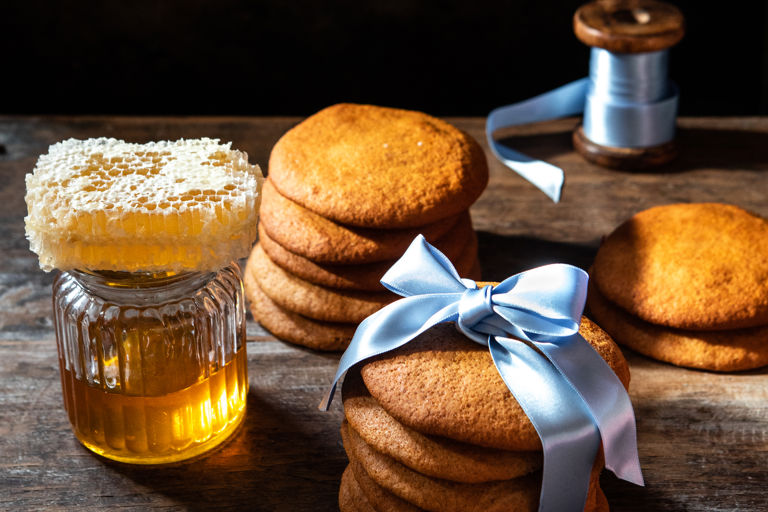Couque de Rins (cakey honey biscuits)
These cakey, honey-filled Belgian biscuits are from Regula Ysewijn's book on the food of the Low Countries. They're easy to make - although take care with the hot honey and sugar mixture. The dough needs to rest overnight, so be sure to start a day in advance.
This recipe is taken from Dark Rye and Honey Cake: Festival baking from the heart of the Low Countries by Regula Ysewijn (Murdoch Books, £26). Photography by Regula Ysewijn
Regula says: 'The couque de Rins is a honey cake variation of the couque de Dinant, with the addition of sugar to make the couque soft instead of rock-hard. The result is a sweet chewy cake full of honey flavour.'
'It was invented by couquier François Rins in the 19th century, by mistake. He added sugar instead of honey, then added honey and cinnamon, trying to cover it up. I can’t tell you how many origin stories of bakes resulted from ‘mistakes’! Today both types of couque are sold in Dinant. The couque de Rins is usually sold in stacks, tied together with a ribbon. This recipe is based on one I found tucked into one of my old cookery books.'
Ingredients
Metric
Imperial
- 300g of runny honey
- 100g of Demerara sugar
- 270g of plain flour
- 3g of potassium carbonate powder, sometimes this is sold as crystals, but you can crush them to powder using a mortar and pestle
Equipment
- 7cm round cutter
Method
Start a day ahead of baking
Heat the honey and sugar in a medium saucepan over a low heat and remove from the heat just before it starts to boil, at the moment when the honey starts to move inward. Put the flour, potassium carbonate and cinnamon into a large bowl and make a well in the centre, then pour in the hot honey mixture and stir with a sturdy wooden spoon. The dough will seem too runny, but will firm up after a night’s rest. Set aside to rest overnight
- 300g of runny honey
- 100g of Demerara sugar
- 270g of plain flour
- 3g of potassium carbonate powder, sometimes this is sold as crystals, but you can crush them to powder using a mortar and pestle
Preheat the oven to 210°C/gas mark 7. Do not use the fan setting. Line a baking tray with baking paper
Scrape the dough out of the bowl and knead on a floured work surface until it is no longer crumbly and sticky
Roll out until 5 mm thick and use a 7 cm diameter cutter to cut out rounds. Lay them on the baking tray with ample space between them, as they will spread to 10 cm diameter
Bake for 10 minutes or until golden, not golden brown. Transfer to a wire rack to cool, then keep in an airtight container for up to 3 weeks
Get in touch
Please sign in or register to send a comment to Great British Chefs.



